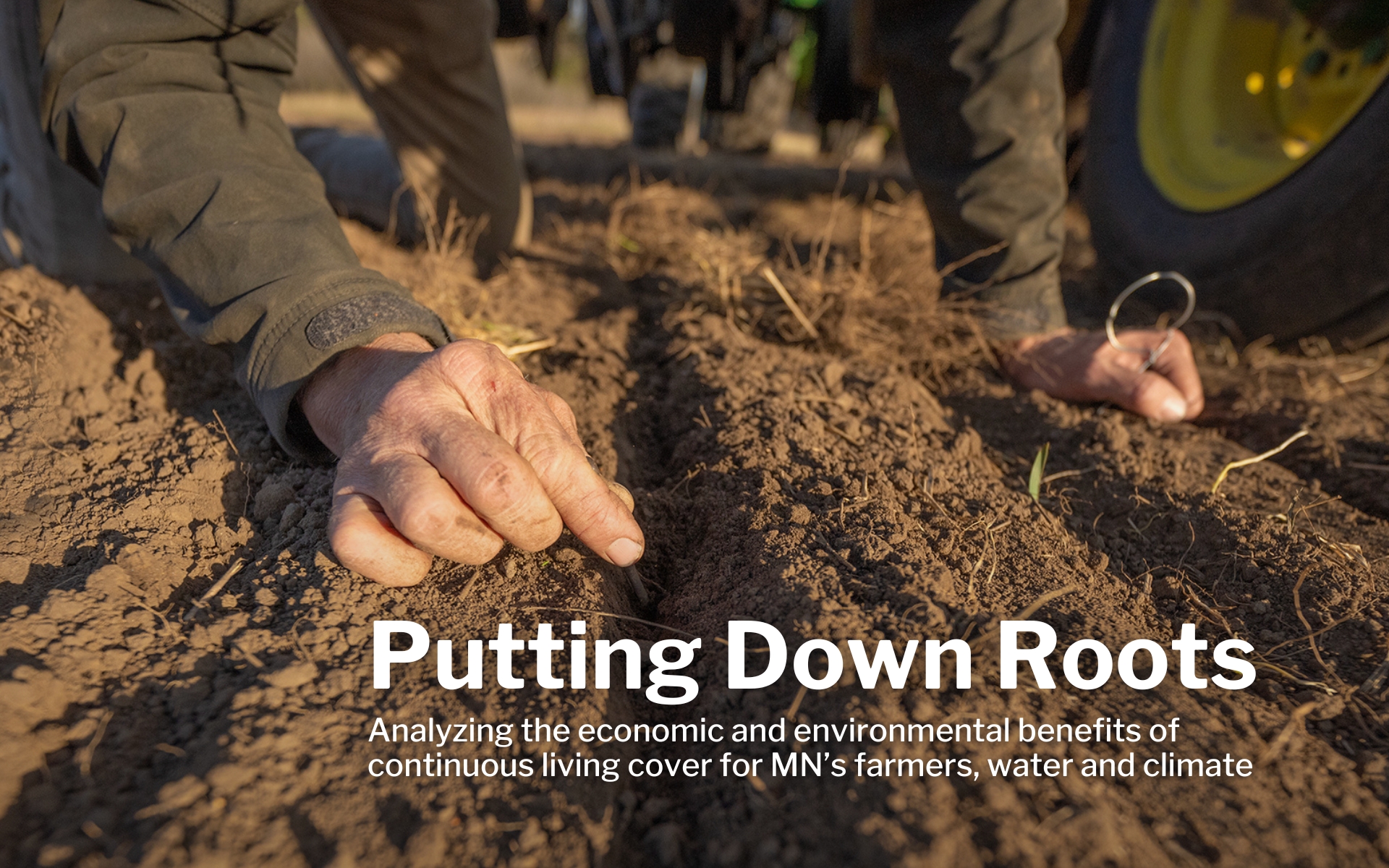Just released: Read the landmark new report 'Putting Down Roots'

(Photo by Dodd Demas for FMR)
We are thrilled to announce the long-awaited release of "Putting Down Roots," a landmark new report that lays out a realistic path to both cleaner waters and more profitable farms through the use of continuous living cover.
As featured in MPR News, the Star Tribune and Morning Ag Clips, the report found crops that provide year-round living cover could reduce nitrogen loss by 23% and soil erosion by 35% in Minnesota by 2050. Farmers who grow these harvestable cover crops would also be positioned to take advantage of emerging commercial markets, particularly in the biofuels space, with the report’s analysis projecting a 20% increase in on-farm profits over that same time period.
“This is an opportunity to turn bare, unused cropland acres into powerful engines for a healthier environment and economy,” said Trevor Russell, water program director at Friends of the Mississippi River and a lead author on the report. “I call it a win-win.”
Produced by Ecotone Analytics, Friends of the Mississippi River and the Forever Green Partnership, the report offers a clear-eyed assessment of the continuous living cover cropping systems being developed by the University of Minnesota's Forever Green Initiative. Through a combination of literature reviews, subject matter expert interviews and scenario development, the project team (with support from more than 50 advisors) forecast how many acres of each crop we could reasonably expect to see planted in Minnesota between now and 2050 — and from that, measured the resulting environmental and economic benefits.
These impacts are made possible through the presence of continuous living cover, explained the Forever Green Initiative’s Associate Director Mitch Hunter. That means live roots in the ground year-round to anchor the soil, while above, green growth covers the "big brown spot."
This coverage — a contrast to the short growing season of conventional summer crops, which are only in the soil a few months of the year — helps keep excess nutrients from escaping into ground and surface water. The crops themselves also provide a new source of revenue.
“We sometimes call these ‘cash cover crops’ because they can be harvested and sold,” Hunter said. “That gives them a significant advantage over conventional cover crops.”
Driving down emissions on and off the farm
The emissions analysis conducted for “Putting Down Roots” focused on direct emissions from farm operations. Researchers project a net reduction of on-farm greenhouse gas emissions as acreage of continuous living cover crops increases in the decades ahead.
Notably, the winter oilseeds that are part of this suite of crops also have the potential to drive down lifecycle emissions in the transportation sector significantly — the state's largest source of greenhouse gas emissions. Winter camelina and domesticated pennycress can both be processed to create renewable biodiesel or sustainable aviation fuels that produce dramatically fewer greenhouse gas emissions than fossil fuels and other biofuel feedstocks, while also protecting soil and water. The promise of these oilseeds has already garnered significant investments from companies in the agriculture and energy sectors and support from the State of Minnesota.
"This projected reduction in on-farm emissions, combined with what we know about the impact of winter oilseeds-based biofuels on life cycle emissions, is really exciting,” said Peter LaFontaine, agricultural policy manager at Friends of the Mississippi River. “The winter oilseeds can be a huge driver in reducing greenhouse gases from hard-to-electrify segments of the transportation sector while, at the same time, significantly enhancing farmers’ bottom line and improving water quality.”
More resources
Download the full report
Help spread the word
Want to share the report's release? Check out our "Putting Down Roots" communications kit to access images, embeddable content, social media posts and other resources.
For the media
Report funding and acknowledgments
This project was made possible with the generous support of the Walton Family Foundation and the Forever Green Partnership. Funding for this project was provided from the Clean Water Fund as part of the Clean Water, Land, and Legacy Amendment.
Friends of the Mississippi River is a nonprofit that works to protect and enhance the Mississippi River and its watershed. Ecotone Analytics is an impact analysis consultancy that does benefit-cost, data and strategy analysis for clients’ social, economic and environmental impacts. The Forever Green Partnership is a multi-sector partnership working to to develop crops and markets that will increase continuous living cover.
Become a River Guardian
Sign up and we'll email you when important river issues arise. We make it quick and easy to contact decision-makers. River Guardians are also invited to special social hours and other events about legislative and metro river corridor issues.